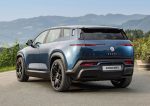
Fisker EV Startup Files for Bankruptcy and Seeks to Liquidate Assets
The electric vehicle (EV) startup Fisker Inc. has filed for Chapter 11 bankruptcy protection, aiming to restructure its debt and sell off assets to salvage its operations. This move comes after the company burned through substantial cash reserves in an effort to scale up production of its Ocean SUVs.
Fisker’s financial troubles are not unique in the fiercely competitive EV market, which has seen other companies such as Proterra, Lordstown Motors, and Electric Last Mile Solutions also file for bankruptcy in recent years. These companies have struggled with weakening demand, difficulties in raising funds, and operational challenges exacerbated by global supply chain issues.
Founded by renowned automotive designer Henrik Fisker, the company had been grappling with doubts about its viability since February. An anticipated investment from a major automaker, reported to be Nissan, fell through, leading to the collapse of a $350 million funding deal that was contingent on this investment. This left Fisker with no choice but to explore alternative options.
“Like other companies in the electric vehicle industry, we have faced various market and macroeconomic headwinds that have impacted our ability to operate efficiently,” Fisker stated.
In its bankruptcy filing in Delaware, Fisker Group Inc. estimated its assets to be between $500 million and $1 billion, with liabilities ranging from $100 million to $500 million. The filing also revealed that Fisker’s 20 largest creditors include major companies such as Adobe, Alphabet’s Google, and SAP.
Fisker’s journey in the EV market has been tumultuous. The company went public in late 2020 through a merger with a blank-check firm, which valued it at $2.9 billion and injected over $1 billion in cash into its balance sheet. This public listing was seen as a second chance for Henrik Fisker, whose first venture, Fisker Automotive, filed for bankruptcy in 2013 following the 2008 financial crisis and issues with the Karma hybrid sedan.
Henrik Fisker had ambitions to position the company as the “Apple of the auto industry” by adopting an “asset-light model,” which involved outsourcing the manufacturing of its cars. This approach was intended to reduce vehicle development times and lower costs. However, the company’s Ocean SUV has been plagued with software and hardware issues, earning criticism from Consumer Reports for being “unfinished business.” The vehicle is currently under regulatory investigation for braking issues, problems with shifting into park and other modes, and doors failing to open at times.
Despite producing over 10,000 vehicles last year, Fisker managed to deliver less than half of them. In a bid to boost sales, the company shifted to a dealership-based distribution model in January, moving away from the direct-to-consumer approach pioneered by Tesla. Fisker signed agreements for 15 dealer locations in the U.S. and 12 partners in Europe, but still struggled to clear its inventory of more than 5,000 cars.
“Fisker has been on life support for months now, so today’s announcement doesn’t come as a surprise. It wasn’t the first EV upstart to declare bankruptcy and we don’t think it’ll be the last,” said Garrett Nelson, vice-president and equity analyst at CFRA Research.
The filing of Fisker’s bankruptcy marks a significant chapter in the EV industry’s ongoing challenges. As the market continues to evolve, the fate of other startups remains uncertain, highlighting the complexities and risks inherent in the rapidly changing automotive landscape.

